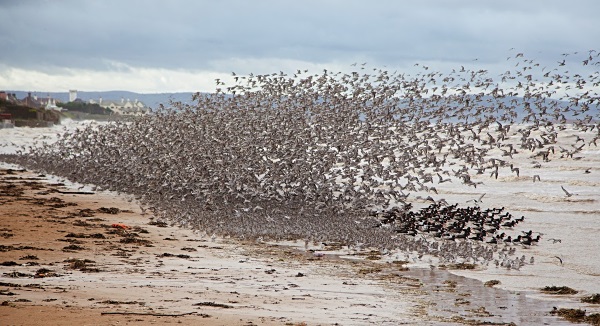Site menu:
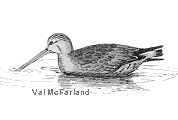
September 2015 Newsletter
The Godwits of Gilroy.
Colour Ring Report - Godwit Special.
Wirral Wader Festival.
August Bird News.
Forthcoming Events.
Latest Newsletter.
The Godwits of Gilroy
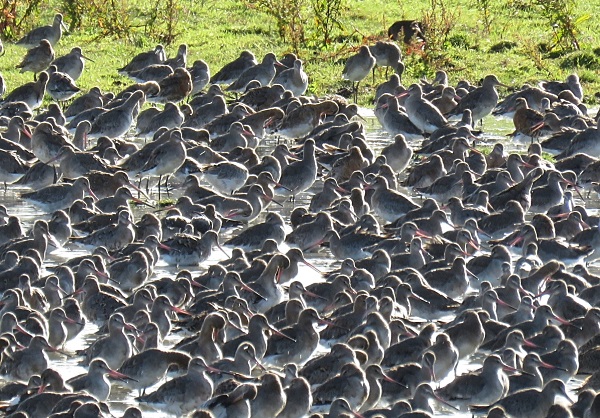
It seems amazing that over the past two years our small flooded field
next to Gilroy Nature Park in West Kirby has become one of the most
important sites in the country for migrating Black-tailed Godwits,
particularly during the months from August to October when they are
undergoing their post-breeding moult. The graph
below shows the weekly max from March 2014 to February 2015, a
particularly good 12 months.
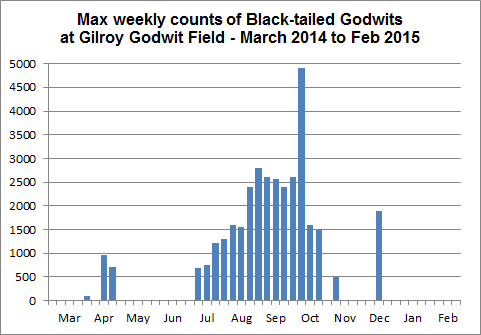
This field, with a busy footpath full of dog walkers and cyclists on one side and a housing estate down the other, is no more than two acres in area yet has held over 10% of the country's Black-tailed Godwits when 4,900 were counted on October 10th 2014. That maximum count may have been a one off but since 2008 we have had no less than 79 individual counts of International Importance, and over the past two years 21 of these have been greater than 2,150, or 5% of the UK population. To put these counts into a National perspective the whole of the Thames Estuary, the second most important site in the UK, had a maximum count of 5,806 in the winter of 2013/14, just 906 more than our max. Another important site, Morecambe Bay, had a max of 2,693 in 2013/14 - twice in 2014 Gilroy had higher counts and, by my reckoning, Morecambe Bay is at least 3,800 times bigger!
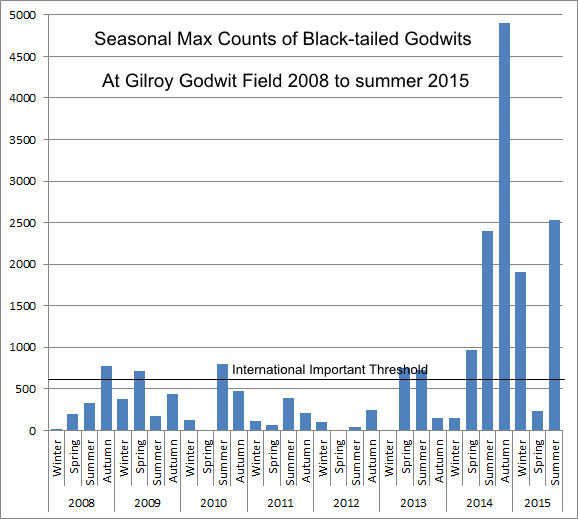
The graph above shows max counts for each season from the winter of 2007/08 to the summer of 2015, with the crucial International Importance threshold of 610 shown. Crucial, as this has implications under the Habitats Directive 2010 regarding the future protection of this site. The high numbers mean that it has a strong functional link to the Dee Estuary Special Protection Area and Ramsar site, in other words Black-tailed Godwits from the Dee Estuary SPA depend on Gilroy on a routine basis, and it's loss would have a serious negative impact on the SPA even though it is outside it's boundary. Interestingly, the counts are so high at Gilroy that theoretically it could be designated an SPA in it's own right, although more likely it could be incorporated into the Dee Estuary SPA and that is a realistic possibility.
At present, other than this 'functional
link', the Gilroy
field has no protection whatsoever and is therefore vulnerable to any
development and/or change of use. Unfortunately such a development is
very much on the cards with the planned Hoylake Golf Resort which it is
said will stretch right across the Hoylake Langfields between Hoylake
and West Kirby. Although we do not yet have details of this project I
do know there is a lot of opposition to it, not least from golfers as
every local golf course is losing members and the last thing they need
is two more golf courses to compete against! That aside, if
this Golf Resort does go ahead I see this as an opportunity to
incorporate the Gilroy flooded field into the scheme as a wildlife
feature and that will be something we will be pushing for.
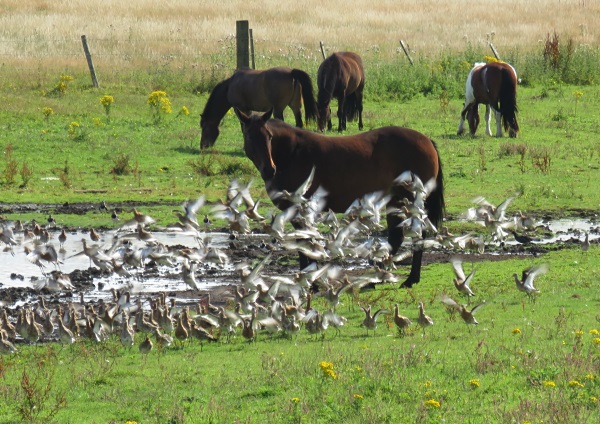
To visit the Godwit field at Gilroy take the path that runs across the
fields from Gilroy Road in West Kirby to Hoylake Station (nearest post
code is CH48 6DG), as you go
through the gate at Gilroy Road the godwit field is on your right with
a good viewing point about 50 yards further on. I can't guarantee any
Godwits but from mid-July to mid-October they are usually
there over high tide specially on spring tides, on neap tides they are
a bit more unpredictable. When they are not at Gilroy you can see them
feeding on the Dee Estuary but in the summer they tend to be a long way
out on Dawpool Bank. If the godwits are at Gilroy it is more than
likely I'll be there - so come and say hello.
Sources of Information for this article:
1. On-line WeBS Report 2013/14 - http://www.bto.org/volunteer-surveys/webs
2. David Parker - Chair of Dee Estuary Conservation Group.3. Tim Melling - RSPB North-west Conservation Officer.
4. All the people who have done counts at Gilroy as well as myself, in particular Chris Butterworth, Matt Thomas and Paul Whitehead.
Richard Smith
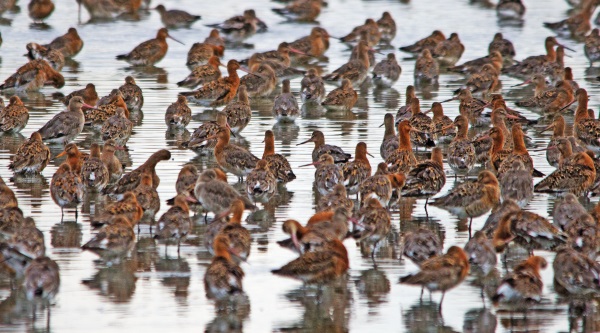
© Elliot Monteith. www.birdboy101.co.uk/
Colour Ring Report -
Godwit Special
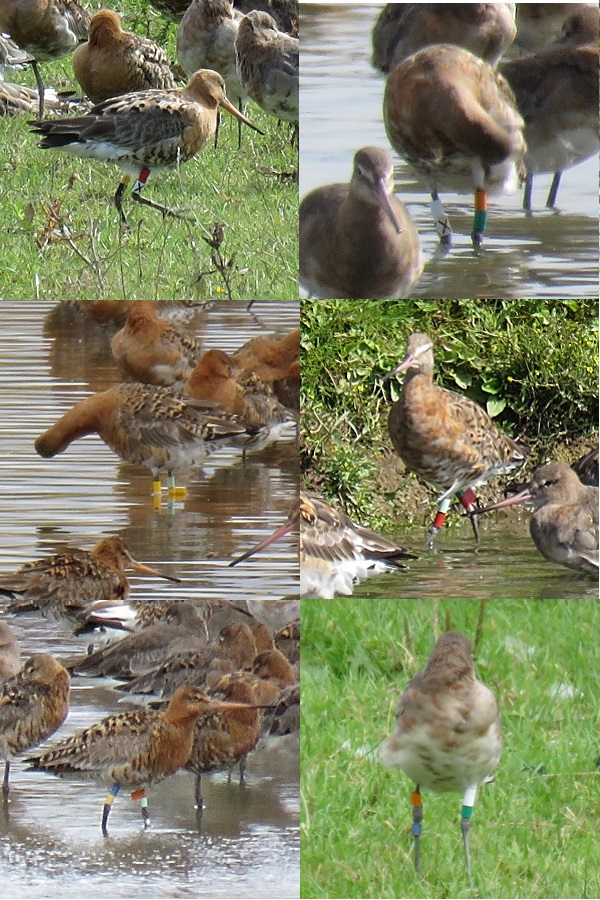
All photos by Richard Smith - all photos taken at Gilroy this summer.
I know Black-tailed Godwits tend to
predominate in
these reports already, but given the article above and the large
numbers we've seen at Gilroy over the past month I'm afraid they
predominate even more in this newsletter! We saw 20 colour
ringed
birds at Gilroy in July and August this year and here are details of
the six in the photographs. They are a good representative of the birds
we see as they include records from throughout their range - Iceland to
Spain and east to the Netherlands.
Recorded at Gilroy Nature Park, West Kirby, on August 18th 2015 and on seven more dates until month-end.
A regular around the Dee estuary since first being seen at Gilroy on September 20th 2009. It was recorded at Gilroy, Caldy, Newton, Thurstaston, Talacre and Burton Mere Wetlands over the succeeding six years (except for 2010 when it wasn't recorded anywhere). Last year this bird turned up at Gilroy on 11th July so we were concerned when there was no sign of it, having heard of several fatalities in Iceland during bad weather in spring, so we were glad to see our old friend when he eventually turned up.
Early in 2015 it was recorded on Thurstaston shore and in inland fields at Caldy and Newton. Since the last winter record on February 17th it moved to Leighton Moss (a favourite site) in April before migrating to Iceland where it was seen twice in May - the first time it has been recorded back in Iceland since 2011.
OG-WX ringed as an adult in northern Iceland on July 13th 2011.
Recorded at Gilroy Nature Park, West Kirby, on August 15th 2015 and a further four dates to month-end.
Seen on the Tagus estuary just inland of Lisbon, Portugal, on February 10th 2013 and ten days later on the west coast of France. By March 2013 it had reached Belgium just south-east of Ghent (the first bird on our records which has been recorded in Belgium). March 13th 2015 saw it in the Netherlands south-east of Rotterdam.
LR-GRflag ringed as a chick in northern Iceland on July 10th 2009.
Recorded at Gilroy Nature Park, West Kirby, on August 17th 2015 and on three more dates to the month-end.
First record after ringing was from north-west Spain, on the coast west of Pontevedra, on November 21st, 2009. Being an immature bird it didn't return to Iceland but spent the whole of the following year in that area and was still there in early May 2011. It has been recorded there every winter since, except for 2014/15, the last record from Spain being in February 2014.
The first record for the UK, and the only one outside the Dee estuary, was at the National Wetland Centre for Wales (Llanelli) on April 27th 2012. August 2013 saw it at both Parkgate and Inner Marsh Farm, and by September 2013 it was recorded several times on Thurstaston shore. A visit to Parkgate in early October 2013 was the last record for the Dee estuary until it arrived at Gilroy in August 2015.
WG-O//B ringed as an adult in Montrose Basin, north-east Scotland, on September 21st 2013.
Recorded at Gilroy Nature Park, West Kirby, on July 20th 2015 and a further 11 dates to August 8th, as well as on Thurstaston shore on July 24th.
After being ringed it moved to the Pagham and Chichester Harbours area in November 2013 and it was recorded again in that area from March until early May 9th 2014. It was twice seen in southern Brittany the following winter, the last record being on January 17th 2015.
July 19th 2015 saw it at the Port Sunlight River Park (next to the Mersey estuary) before it flew across Wirral to Gilroy where it was the following day.
OflagL-BY ringed in Yves, west coast of France (near Rochefort) on September 29th 2008.
Recorded at Gilroy Nature Park, on August 3rd and 5th 2015.
Has spent every winter at, or near, the ringing location in France since it was ringed in 2008. Some years the bird stayed in France until mid-April but in 2015 the last winter/spring record was February 20th. In 2009 and 2013 it returned to France as early as mid-July, so this year it will have been late back. The only record not in France (prior to it's arrival at Gilroy) was in the outskirts of Amsterdam on February 21st 2014.
YW-LYflag ringed as a chick in north Iceland on July 12th 2012.
Recorded at Gilroy Nature Park, West Kirby, on July 16th 2015 and a further eleven dates up to the end of August, as well as on Thurstaston Shore on August 24th 2015.
First record after ringing was at Oakenholt on October 18th 2012. Since then most records are during the spring and autumn migration and it has been recorded at Gilroy many times, but also seen at Burton Mere Wetlands and Thurstaston shore. It appears to have over-summered on the Dee estuary in 2014. There are no records of this bird for the winter months of 2013/14 or 2014/15, it was at Gilroy on October 2nd 2014 then wasn't seen again until it turned up at Burton Mere Wetlands on April 12th 2015. The only record away from the Dee estuary was at Carr Lane Pools, Hale (next to the Mersey estuary) on August 14th 2013.
Richard Smith and Matt Thomas.
Colour-ringed birds were also recorded by Colin Schofield, Elliot Monteith and Steve Hinde.
Top of Page
Wirral Wader Festival -
November 2015
Wirral Wader Festival November 14th and 15th.
In conjunction with Bird Watching Magazine, Wader Quest, Wirral
Council's Rangers at
Thurstaston Country Park, Dee Estuary Voluntary Wardens, RSPB and
Cheshire Wildlife Trust. This will be a festival celebrating waders in Wirral with events at Thurstaston Country Park, Hoylake, Red Rocks, West Kirby, New Brighton Marina and the RSPB Dee Estuary reserve.
Further details will be in the October and November Newsletters at www.deeestuary.co.uk.
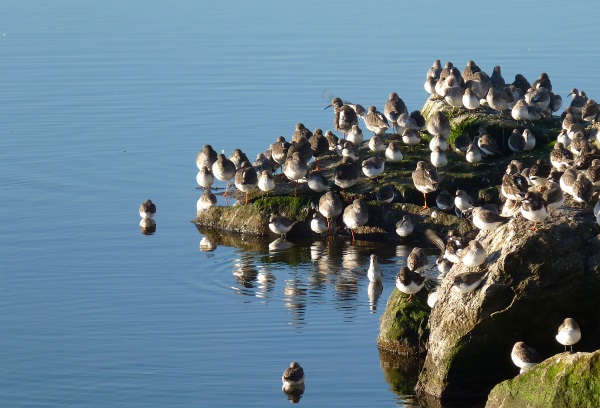
Top of Page
August Bird News
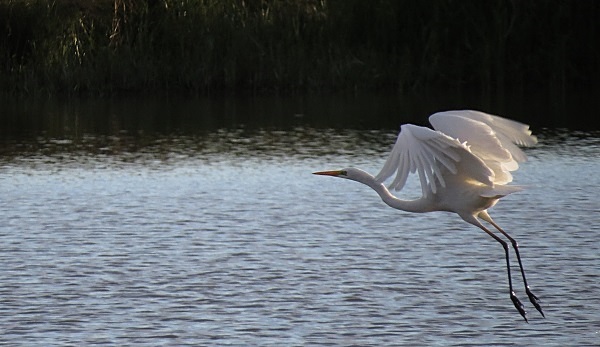
The bird of the month was a Bee-eater which flew over the Shotton Reserve early in the morning on the 20th, unfortunately it flew towards Chester and was never seen again.
One or two Great White Egrets were reported throughout the month culminating with three at Burton Marsh on the 31st, it's been at least two years since we last had three. At Burton Mere Wetlands there was an influx of Ruff through the month with a max count of 23 on the 27th; a Curlew Sandpiper was there for the last week and also several reports of a Little Stint. An adult Curlew Sandpiper was at Heswall on the 12th.
For other waders it's been fairly quiet - except for the Black-tailed Godwits at Gilroy, of course, which increased from 920 to 2,530 through the month.
There were several reports of Kingfishers including one at Red Rocks where they are rare, and two were by the Duck Pond at Leasowe Lighthouse.
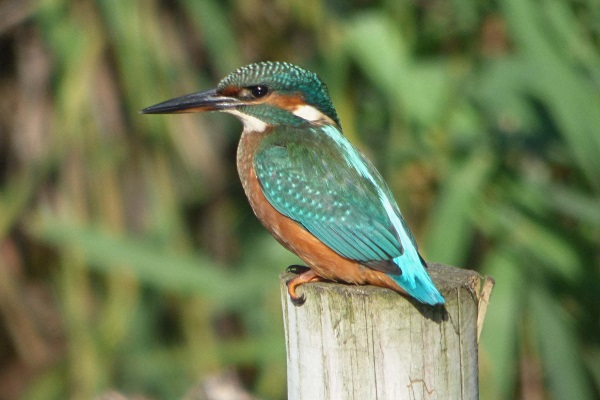
It was a good month for Harriers with a max count of four Marsh, three of these were juveniles and included one which had green wing tags. We were unable to read the letters on these tags but we know these birds are tagged in north Norfolk, this is a very unexpected north-west movement across the country for this species but it's not the first time we've seen this, we had two wing-tagged Marsh Harriers in 2012. There have also been two ringtail Hen Harriers quartering the marshes, one was seen soaring with three Common Buzzards over Neston Marsh on the 24th. There were two reports of Ospreys over the month, they are always much scarcer during their return migration than in the spring. I also had a report of a Red-tailed Hawk in West Kirby, obviously this is an escape but this bird has now been in this area for over two years - apparently it eats Herring Gull chicks in the summer!
There were six records of Hobbies, one flew right over my head at Gilroy chasing House Martins.
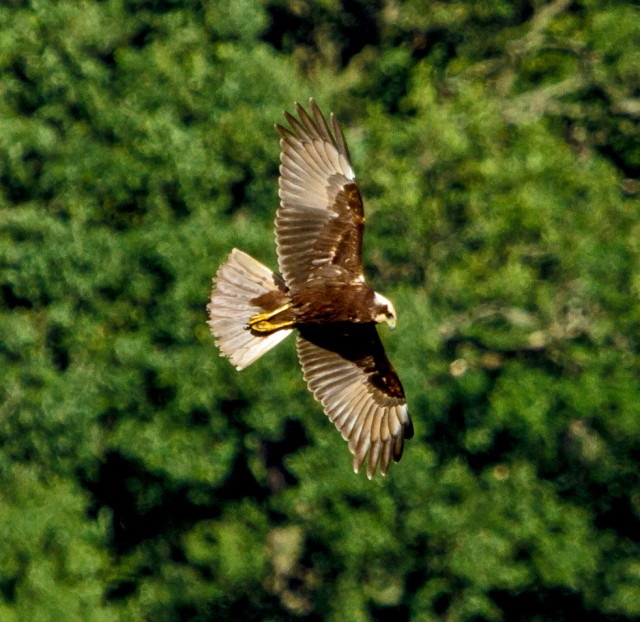
There were some spectacular gatherings of terns and gannets off Hilbre and Red Rocks, the 20th seems to have been the best day when a 'maelstrom' of over a thousand terns (Sandwich, Common and Little) where seen feeding at high tide and were joined by at least 80 Gannets close inshore with three Arctic Skuas in attendance. Six Arctic skuas were counted on the 21st and 29th. Two single Black Terns were recorded from Hilbre towards the end of the month and three Arctic Terns were on East Hoyle Bank on the 13th. It's been a relatively poor summer for Manx Shearwaters but a run of south-westerlies resulted in at least 100 flying past on the 27th.
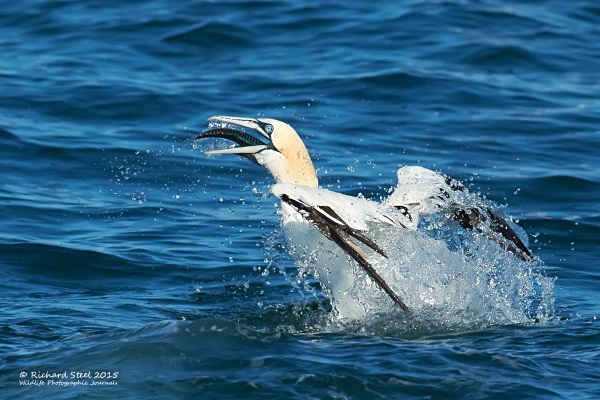
Richard Smith.
What to expect in September
Both 2013 and 2014 were good for Curlew Sandpipers, but we also had a good selection of other waders including a Semi-palmated Sandpiper, several Little Stints, a Dotterel, a Red-necked Phalarope, a Pectoral Sandpiper as well as good numbers of Ringed Plovers, Sanderling and Dunlin. The weather in September 2014 was very settled, good for an exceptional passage of Grey Wagtails as well as a good migration of warblers, including a Marsh Warbler at Red Rocks.
There are some high spring tides both at the beginning and end of the month, they will bring waders close to the promenade at Hoylake making for some spectacular views and may well be high enough to cover the marsh at Parkgate.
Top of Page
Forthcoming Events
September Highest Spring Tides (Liverpool)
Also
see Tides
page.
1st September, 13.41hrs (BST), 9.9m.
28th September, 11.52hrs (BST), 9.9m.
29th September, 12.36hrs (BST), 10.0m.
30th September, 13.19hrs (BST), 10.0m.
Forthcoming Events
Organised by the Wirral
Ranger Service , Flintshire
Countryside Service and the
RSPB (Dee Estuary):
All these events and walks have bird interest, even those not
advertised specifically for birdwatching. No need to book for these
events unless specified - please check below.
Also see 2015 Events Diary.
Price: Adults £5; RSPB members £4; children half price
Booking essential Telephone: 0151 353 8478.
Two of Burton Mere Wetlands' greatest spectacles at this time of year take place as daylight fades, when little egrets fly to roost in the treetops of Marsh Covert and various bats emerge to feed over the pools. This exciting evening walk is your chance to discover the dusk spectacle in all its glory guided by a member of the reserve team.
The Dee Estuary supports the third largest little egret colony in the north of England, and watching them gather into their communal roost is truly amazing. Once the egrets are settled in, attention turns to the bats, with noctules, pipistrelles and Daubenton's the stars of the show, the latter swooping low over the pools to catch insects.
Our bat detectors will enable you to hear the otherwise ultrasonic calls of the bats as they fly inches past our heads - bring your own if you have one. Plus, there's always a chance of catching a glimpse of the reserve's other nocturnal residents.
The trails are fully accessible and the walk less than a mile in total, so the event is suitable for people of all ages and abilities. Price includes a hot drink and snack in the Reception Hide. Places are limited so book in advance to avoid disappointment.
Sunday 6th September and Sunday 4th October, Skydancers on the Dee at the Donkey Stand at Parkgate (opposite Nicholl's Ice Cream Shop).
1 pm - dusk
Price: Free
Most people have never seen a hen harrier, but once seen it is rarely forgotten. In support of the RSPB's Skydancer project, we are pleased to bring you a series of events to showcase these enigmatic birds of prey which use the marshes of the Dee Estuary as their home for the winter months.
The name "Skydancer" comes from the aerobatic displays that the male birds perform in their courtship ritual on the moors in the spring. Sadly, this has become an increasingly rare sight and they are close to becoming extinct as a breeding bird in England.
This could be the last chance to see Skydancers on the Dee, so come along to Parkgate to find out more about the hen harrier story and what you can do to help save them before it's too late. Look for the RSPB marquee along the main promenade at Parkgate, where friendly staff and volunteers will be on hand with telescopes and binoculars to show you these beautiful, agile birds hunting over the marsh, and coming in to roost there at dusk. Plenty of family activities and other RSPB information will be available.
Car parking is limited on Parkgate promenade, but there is free public parking at the Old Baths car park (CH64 6RN) at the north end of The Parade, and the Wirral Country Park car park on Station Road (CH64 6QJ). There are public toilets at Mostyn Square in the middle of The Parade, and a number of pubs and cafes for refreshments. Wrap up warm, and prepare to be patient as the harriers have a large area of marsh to roam!
For more information on the RSPB's Skydancer project, visit
http://www.rspb.org.uk/skydancer/
September 26th, Weekend Walkabout at
RSPB Burton Mere Wetlands.
1 pm-3 pm (approx. finish)
Price: Free (normal reserve entry charges apply to non-members)
Join one of our friendly, knowledgeable volunteers for a
gentle walk from the Reception Hide to the end of the Hillfort Trail on
Burton Point, to learn more about the wildlife that thrives here, the
work we do to give nature a home and the remarkable history of the
estuary
Great for first time visitors or those who'd like a guide to help them
get the most enjoyment from a visit. With constant changes as we move
through the seasons, it's impossible to predict what might be seen but
large numbers of herons and egrets, ducks and geese returning for the
winter are guaranteed at this time of year. With a variety of birds of
prey and some late butterflies and dragonflies if the sun is shining,
there's always something to marvel.
No booking required, just turn up on the day. A reasonable level of
fitness and sturdy footwear are required.
Tuesday 29th September and Wednesday 30th September, Parkgate High Tide Bird Watch.
The
marsh at Parkgate is one of the best wetland habitats in the northwest,
and when it is flooded by an incoming Spring high tide, the wildlife
which lives here is pushed closer, potentially delivering an
awe-inspiring spectacle. Join us at Parkgate's Old Baths car park and
the Donkey Stand near Nicholl's ice cream shop, where we'll be set up
with marquees and telescopes hoping for the right weather conditions to
really push the tide in.
You can expect great views of the large
numbers of wintering wildfowl and wading birds shifting around to avoid
the rising water, whilst the small mammals living on the marsh are
flushed from cover, offering a feeding frenzy for the resident kestrels
and hopefully harriers and short-eared owls returning for the winter.
Car
parking is limited on Parkgate promenade, but there is free public
parking at the Old Baths car park (CH64 6RN) at the north end of The
Parade, and the Wirral Country Park car park on Station Road (CH64
6QJ). There are public toilets at Mostyn Square in the middle of The
Parade, and a number of pubs and cafes for refreshments.
Additional parking has also kindly been offered at Marsh Nurseries,
Boathouse Lane (postcode CH64 6RD).
Please
note: the height of the tide can be hugely affected by the weather
conditions on the day. In the event of high pressure and calm
conditions, the tide will cover much less of the marsh and not reach
the sea wall, whilst low pressure and strong Westerly winds will help
push the tide in and offer the greatest spectacle. We recommend you
check the weather forecast on the day to know exactly what to expect.
High tide times:
Tuesday 29 September: 12.36 pm (10.0m)
Wednesday 30 September: 1.19 pm (10.0m)
Sunday 18th October - Deeside
Naturalists’ Society – Open Day
Deeside
Naturalists’ Society invite you to visit Connah’s Quay Nature Reserve
on Sunday 18th October from 10am to 3pm. The five observation hides and
Field Studies Centre will be open for use and tea and coffee will be
available. There will be a high tide at 2.40pm. Admission is
free
on the Open Day to the public (entrance is normally by permit or
membership only).The reserve is located along the Welsh shoreline of
the River Dee and holds SSSI and Ramsar site status. It also is a
Special Protection Area. Directions to the reserve - From A548 take the
Connah’s Quay turn off and follow the Power Station signs. At the
reserve entrance a member of the society will meet visitors and give
directions.
For further information/directions see website www.deesidenaturalists.org.uk
Saturday 31st October, Autumn
Arrivals at Point
of Ayr.
10.30 am-2 pm (approx. finish)
Price: Free, but donations gratefully received on the day
Booking essential Telephone:
0151 353 8478.
By
late Autumn we'll have welcomed many of our winter visitors back to the
mudflats and saltmarsh that make the Dee Estuary such an important home
for wetlands birds, and witnessing a high tide at the Point of Ayr is a
spectacle not to be missed.
Thousands of godwits, redshanks,
oystercatchers and curlews gather in spectacular fashion on the
saltmarsh and shingle here at high tide, which is what we hope to show
you if you join us on this gentle walk from Talacre to our hide.
There'll also be a variety of ducks - pintail, shelduck, teal and
mallard - pushed close on the incoming tide, and there's always the
chance that something unexpected will show its face! Peregrine and
merlin are the two raptors most likely to take advantage of this high
tide buffet, so there's a chance of seeing these hunting at close
range.
Park in one of the public car parks signposted from
Station Road and meet outside the Smuggler's Inn at the end of Station
Road. Appropriate clothing and footwear are essential. The path is
fully accessible, but a motorcycle gate at the beginning of the walk
may make it difficult for larger wheelchairs. High tide is at 1.24 pm
so pack some lunch or snacks, and a hot flask is recommended at this
time of year!
